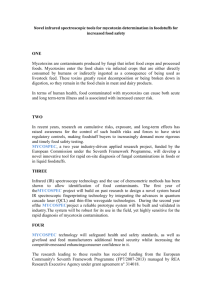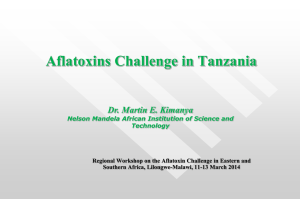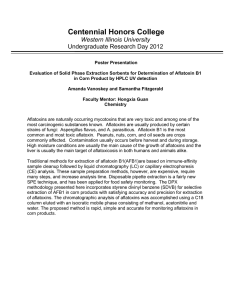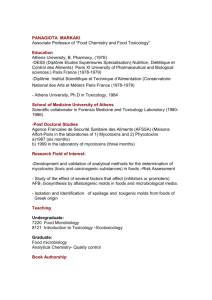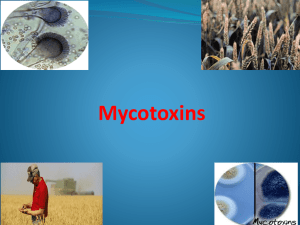REGULATIONS OF THE EUROPEAN UNION FOR MYCOTOXINS IN
advertisement
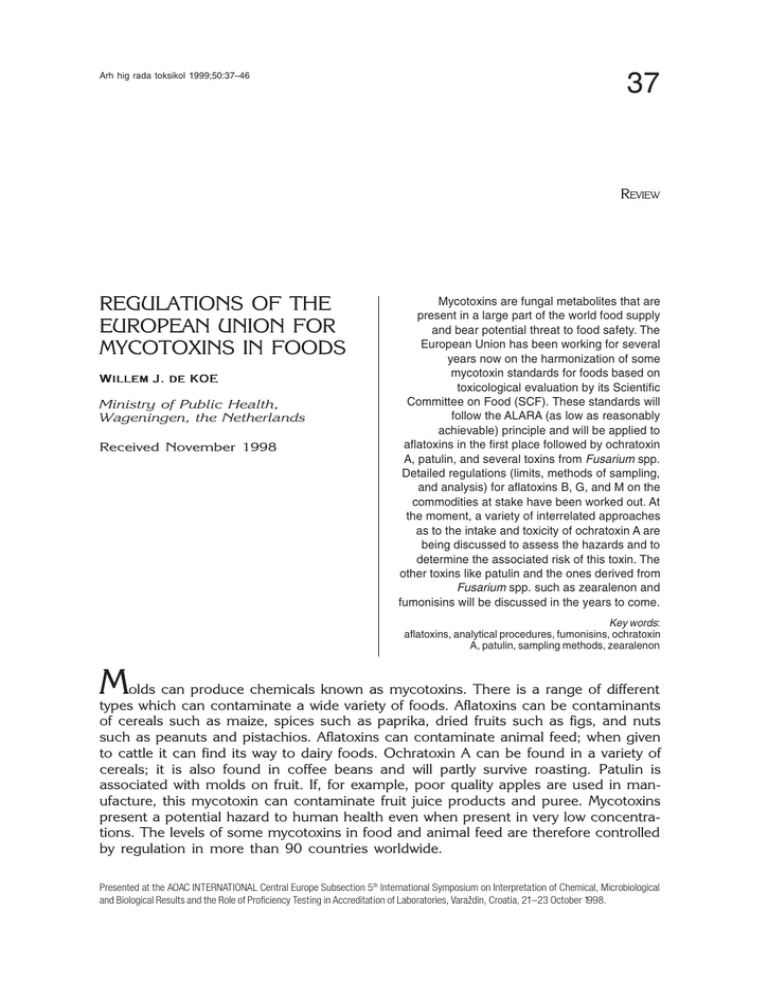
Arh hig rada toksikol 1999;50:37–46
37
REVIEW
REGULATIONS OF THE
EUROPEAN UNION FOR
MYCOTOXINS IN FOODS
W illem J. de KOE
Ministry of Public Health,
Wageningen, the Netherlands
Received November 1998
Mycotoxins are fungal metabolites that are
present in a large part of the world food supply
and bear potential threat to food safety. The
European Union has been working for several
years now on the harmonization of some
mycotoxin standards for foods based on
toxicological evaluation by its Scientific
Committee on Food (SCF). These standards will
follow the ALARA (as low as reasonably
achievable) principle and will be applied to
aflatoxins in the first place followed by ochratoxin
A, patulin, and several toxins from Fusarium spp.
Detailed regulations (limits, methods of sampling,
and analysis) for aflatoxins B, G, and M on the
commodities at stake have been worked out. At
the moment, a variety of interrelated approaches
as to the intake and toxicity of ochratoxin A are
being discussed to assess the hazards and to
determine the associated risk of this toxin. The
other toxins like patulin and the ones derived from
Fusarium spp. such as zearalenon and
fumonisins will be discussed in the years to come.
Key words:
aflatoxins, analytical procedures, fumonisins, ochratoxin
A, patulin, sampling methods, zearalenon
M
olds can produce chemicals known as mycotoxins. There is a range of different
types which can contaminate a wide variety of foods. Aflatoxins can be contaminants
of cereals such as maize, spices such as paprika, dried fruits such as figs, and nuts
such as peanuts and pistachios. Aflatoxins can contaminate animal feed; when given
to cattle it can find its way to dairy foods. Ochratoxin A can be found in a variety of
cereals; it is also found in coffee beans and will partly survive roasting. Patulin is
associated with molds on fruit. If, for example, poor quality apples are used in manufacture, this mycotoxin can contaminate fruit juice products and puree. Mycotoxins
present a potential hazard to human health even when present in very low concentrations. The levels of some mycotoxins in food and animal feed are therefore controlled
by regulation in more than 90 countries worldwide.
Presented at the AOAC INTERNATIONAL Central Europe Subsection 5th International Symposium on Interpretation of Chemical, Microbiological
and Biological Results and the Role of Proficiency Testing in Accreditation of Laboratories, Vara`din, Croatia, 21–23 October 1998.
38
de Koe WJ: EU REGULATIONS FOR MYCOTOXINS IN FOODS
Arh hig rada toksikol, Vol 50 (1999) No 1, pp. 37–46
BACKGROUND OF THE REGULATIONS OF THE EUROPEAN UNION
The European Union (EU) has been working for several years on the harmonization of
mycotoxin standards for foods based on toxicological evaluation by its Scientific Committee
on Food (SCF). These standards will follow the ALARA (as low as reasonably achievable) principle and will be applied to the major mycotoxins.
AFLATOXINS
Mycotoxins have toxic properties and the most notorious ones, the aflatoxins, are liver
carcinogens to humans. They occur on cereals, peanuts, other nuts, dried fruit, milk
(aflatoxin M1), and spices. In 1994, the SCF expressed an opinion on aflatoxins and
also on ochratoxin A (OTA) and patulin (1). It was not a surprise that the EU came
with a regulation (EC) No. 1525/98 of 16 July 1998 (2) amending Commission
Regulation (EC) No. 194/97 of 31 January 1997 (3) setting maximum levels for
certain contaminants (in this case aflatoxins) in foodstuffs that was earlier sent as a
draft to the World Trade Organization (WTO) and registered as notification (G/SPS/N/
EEC/51) by the EU on 8 January 1998.
Beside the low level setting, based on a tolerable exposure of 1 ng/kg b.w./day
or less, sampling procedures and criteria for methods of analysis are described in the
Commission Directive 98/53/EC (4) of the same date. In its draft, the regulation was
highly criticized by the producing countries who seemed to hold laxer views on food
safety and consumer protection and rely on the confusing factors the Joint Expert
Committee on Food Additives (JECFA) (5) brought about at its 49th meeting in 1997
in which hepatitis B and C were mentioned as confounding factors. The basis of the
fundamentally different philosophy of the Europeans is not only the confounding
JECFA report that did not take into account that hepatitis virus is prevalent in Eastern
Europe and the newly independent states of the former Soviet Union (5–12%). The
estimated annual incidence of hepatitis B infection In Central Asia and some Central
and Eastern European countries is 520 infections per 100,000 people. These countries will be regarded as having an intermediate or high endemicity, according to the
World Health Organization (WHO). Furthermore, a report from 1996 issued by the
United States Department of Agriculture (USDA) that summarized the year-by-year
(1975 to 1992) aflatoxin distributions for more than 600,000 lots of peanuts tested
for aflatoxin has been taken into account. More than 90% of the lots of raw peanuts
contained up to 15 µg/kg or less of total aflatoxin and 85% of the lots contained
aflatoxins at levels below 10 µg/kg. Blanching and electronic eye color sorting brought
in almost all cases the level down to below 5 µg/kg of total aflatoxins. The EU is of
the opinion that the ALARA principle can easily be met with some preventive policies
such as good agriculture, manufacturing, and storage practices. The levels are more in
agreement with those set and practiced for feed and aflatoxin M1 in milk (0.05 µg/kg)
in the Union and now also have been proposed to the Codex Commission.
de Koe WJ: EU REGULATIONS FOR MYCOTOXINS IN FOODS
Arh hig rada toksikol, Vol 50 (1999) No 1, pp. 37–46
39
OCHRATOXIN A
In the case of ochratoxin A, commodities such as cereals, cereal products (including
beer), coffee, wine, pork, products containing pig blood/plasma, pulses, and spices
are considered. An updated risk assessment on ochratoxin A published in 1996 based
on a rat study by the National Toxicology Programme (NTP) (6) showed high tumor
and metastasis incidence while the human dietary exposure associated with the Balkan Endemic Nephropathy was also noticed outside the Balkans in countries like
Algeria and Tunisia. A recent SCF report (7) underpins the NTP study. A regulatory
level of 5 µg/kg for cereals and cereal products intended for direct human consumption is proposed.
PATULIN
JECFA established for patulin a provisional tolerable daily intake (PTDI) of 0.4 µg/kg/b.w.
The regulatory level of 25 µg/kg seems to be justified since patulin is found in many
types of fresh or processed fruit and vegetables such as juices, sauces, compotes,
and jellies. Especially apple-juice and sauce seem to contribute to the problem.
OTHER MYCOTOXINS DERIVED FROM FUSARIUM
Regulatory limits for other mycotoxins mainly derived from Fusarium fungi such as the
trichothecenes T-2 toxin, HT-2 toxin, deoxynivalenol (DON) and nivalenol (NIV) and
some other toxins such as zearalenon (ZON), fumonisins, fusarin C, fusarenon-X, diacetoxyscirpenol (DAS), and moniliformin have not reached beyond the discussion stage as
yet, although validated methods of a0nalysis have been worked out in several programs
of the Standard Measurement and Testing, governed by DG XII and standardized by the
European Committee for Standardization (CEN) in its working group on biotoxins
(CEN / TC 275 / WG 5 – Biotoxins) within the Technical Committee 275.
MAXIMUM LEVELS
The European Commission services had to stress the need for encouraging preventive action such as good agricultural practice, research into techniques for contamination prevention, improved training, good storage conditions and the use of improved sorting procedures. The ideas from several member states on levels (almost
40
de Koe WJ: EU REGULATIONS FOR MYCOTOXINS IN FOODS
Arh hig rada toksikol, Vol 50 (1999) No 1, pp. 37–46
all different ranging from several µg/kg to 20 µg/kg) and specific sampling procedures
(UK, Denmark, Norway, and The Netherlands) encouraged the Expert Committee
»Agricultural Contaminants« to come out with the following maximum permitted levels
(µg/kg) that have been fixed for aflatoxin B1 and total aflatoxins (B1, B2, G1, and G2)
in different commodities:
1) Groundnuts, nuts and dried fruita and processed products thereof, intended
for direct human consumption or as an ingredient in foodstuffs: 2 (B1)/4 (total);
2) Groundnutsa to be subjected to sorting or other physical treatment before
human consumption: 8 (B1)/15 (total);
3) Nuts and dried fruitb to be subjected to sorting or other physical treatment
before human consumption or use as an ingredient in foodstuffs: 5 (B1)/10 (total);
4) Cereals (incl. buckwheat, Fagopyrum sp.) and processed products thereof, intended for direct human consumption or as an ingredient in foodstuffs: 2 (B1)/4 (total);
5) Cereals (incl. buckwheat, Fagopyrum sp.) to be subjected to sorting or other
physical treatment, before human consumption or use as an ingredient in foodstuffs:
no specific limit foreseen before 1 July 1999 other than the ones mentioned under 4);
6) The maximum permitted level for aflatoxin M1 in milk (raw milk and milk for the
manufacture of milk-based products and heat-treated milk) has been fixed at 0.05 µg/L.
Decontamination of products by chemical treatment is forbidden as well as any
blending of contaminated products with good quality products in order to reach the
admitted level for human consumption. Clear labeling is compulsory for those products
to be submitted to sorting or other physical treatment to lower aflatoxin contamination
prior to human consumption. The four main aflatoxins (B1, B2, G1, and G2) usually occur
together in varying ratios but normally aflatoxin B1 is the major component. Because
aflatoxin B1 is by far the most toxic compound of all aflatoxins, setting a separate (lower)
level for aflatoxin B1 offers an extra guarantee for public health (the two-tier approach
taken from EEC foodstuffs regulation). Aflatoxin M1 is believed to be significantly less
carcinogenic than aflatoxin B1. However, the intake of milk and milk products by humans
can be considerable, particularly among infants and young children.
METHODS OF SAMPLING AND SAMPLING PREPARATION
The homogeneity of the concentration of mycotoxins in products is a key factor in
establishing regulatory sampling criteria. Distribution can be uneven, as is the case
with aflatoxins in peanuts. The number of contaminated peanut kernels in a lot is
usually very low, but the contamination level within a single kernel can be very high.
If insufficient care is taken in representative sampling, the mycotoxin concentration in
an inspected lot may, therefore, easily be wrongly estimated.
Also, consumption of peanuts may lead to accidental ingestion of a high single
dose of aflatoxins instead of chronic intake at relatively low levels. The situation is
similar with most other products susceptible to mycotoxin contamination such as
a
b
on edible part
reconsidered before 1 July 1999 after technological justification
de Koe WJ: EU REGULATIONS FOR MYCOTOXINS IN FOODS
41
Arh hig rada toksikol, Vol 50 (1999) No 1, pp. 37–46
cereals in which the order of scale (bulk) plays an important role. The risk to both
consumer and producer must be considered when establishing sampling procedures
and it has been in the focus of international concern for a long time. Ceaseless
discussions have sought to find a harmonized international approach to the problem.
The heterogeneous distribution of mycotoxins in relevant commodities can lead to real
problems of observing established levels unless adequate sampling plans are used.
A crucial point in the development of sampling plans seems to be the balance
between the consumer’s and the producer’s risk. With this respect, importing/consuming and exporting/producing countries may take a different view. The US plans
seek to balance such risks (compare weight and measure regulation). The Europeans
have a different approach not only with their weight and measure regulation within the
Community, but more philosophically, by applying the Pareto principle (the principle
of the »vital few and the trivial many«), well known in quality improvement programs.
If the Europeans want to protect their consumers, it is obvious that a balance of risk
is out of the question and that instead of a 50/50 risk balance a risk ratio 20/80 is
more appropriate. The UK aflatoxin regulation on sampling (8), the Dutch »Code of
Practice for Peanuts« (9), the existing legislation on sampling in Denmark and Norway, and the views on sampling in Germany formed the basis for the sampling procedure in the EU Directive 98/53/EC (4). On the other hand, Europeans adopted
none of the technical recommendations published in the FAO Food Nutrition Paper
No. 55 »Sampling plans for aflatoxin analysis in peanuts and corn« (10) in 1993. The
evaluation of sampling plans used in the US, UK, and The Netherlands found the
producer-friendly approach not stringent enough in testing raw shelled peanuts for
aflatoxin (11). The EU proposed sampling plans for different commodities with an aim
to encompass heterogeneous distribution, reach the performance level of less complicated sampling procedures, and respond to requirements related to the dependence of a sample size on the lot size. The EU gives quite detailed definitions as to
what is meant under: »(sub)lot«, »incremental, aggregate, and laboratory sample«,
and gives general and specific provisions shown in Table 1 for aflatoxin in groundnuts
and in Table 2 for aflatoxin in groundnuts and other involved commodities.
Table 1 Number of incremental samples to be taken depending on the weight of the lot
GROUNDNUTS
Lot weight
(tonnes)
Number of incremental
samples
<0.1
≥0.1 – <0.2
≥0.2 – <0.5
≥0.5 – <1.0
≥1.0 – <2.0
≥2.0 – <5.0
≥5 – <10
≥10 – <15.0
10
15
20
30
40
60
80
100
de Koe WJ: EU REGULATIONS FOR MYCOTOXINS IN FOODS
42
Arh hig rada toksikol, Vol 50 (1999) No 1, pp. 37–46
Table 2 Subdivision of lots into sublots depending on product and lot weight for sampling
Commodity
Lot weight
(tonnes)
Weight or No.
of sublots
No. of incremental
samples
Aggregate sample
weight (kg)
≥15
<15
15–30 t
–
100
10–100
30
≤30
Groundnuts,
pistachios, Brazil
nuts, and other
nuts
≥500
>125 and <500
≥15 and ≤125
< 15
100 t
5 sublots
25 t
–
100
100
10–100*
30
30
≤30
Cereals
≥1500
>300 and <1500
≥50 and ≤300
<50
500 t
3 sublots
100 t
–
100
100
100
10–100*
30
30
30
1–10
Dried figs and
other dried fruit
*depending on the lot weight
Sampling procedure
•
•
•
•
•
Each sublot must be sampled separately;
Number of incremental samples: 100. In the case of lots under 15 tonnes, the
number of incremental samples depends on the weight of the lot, and ranges
from a minimum of 10 to a maximum of 100 samples;
Weight of the aggregate sample is 30 kg. It has to be mixed and divided in three
equal subsamples of 10 kg before grinding (the division in three subsamples is
not necessary if the equipment which is able to homogenize a 30 kg sample is
available). In cases where the aggregate sample weights are under 10 kg, the
aggregate sample must not be divided into three subsamples;
Laboratory sample: a subsample of 10 kg (each subsample must be separately
and finely ground and mixed thoroughly to achieve complete homogenization);
Provisions for acceptance of a lot or sublot: acceptance if the aggregate sample
or the average of the subsamples conforms to the maximum limit; rejection if
the aggregate sample or the average of the subsamples exceeds the maximum
limit.
Sample preparation
Several precautions have to be taken: shielding from ultra-violet light; calculation of
proportion of shell/kernel; treatment of sample as received in the laboratory (mix,
homogenize); subdivision of samples for enforcement and defense purposes.
Sampling procedure for milk and milk products
Sampling of these products has to be carried out according to the Commission
Decision 91/180/EEC of 14 February 1991 (12) laying down certain methods of
analysis and testing of raw milk and heat-treated milk and with Commission Directive
87/524/EEC of October 6, 1987 (13) laying down Community methods of sampling
for chemical analysis for the monitoring of preserved milk products. The minimum
de Koe WJ: EU REGULATIONS FOR MYCOTOXINS IN FOODS
43
Arh hig rada toksikol, Vol 50 (1999) No 1, pp. 37–46
number of incremental samples is 5 and a lot is accepted if the aggregate sample
conforms to the maximum limit.
METHODS OF ANALYSIS
In order to apply control on mycotoxins and to set standards for trading purposes it
is necessary to have validated methods for the analysis of mycotoxins. Validated
methods are those which are to be tested by collaborative studies. It is important to
establish performance characteristics such as repeatability and reproducibility, recovery, and limit of detection (14). The methods must be proven effective at levels below
the regulatory limits and appropriate for the target foodstuff. The EU asked the European Committee for Standardization (CEN) in the early nineties to establish methods of analysis in the field of mycotoxins within the »Technical Committee 275 –
Food analysis – Horizontal methods«. The working group »CEN/TC 275/WG 5 –
Mycotoxins« was established in 1992. Five years later it expanded the scope to include phycotoxins (algal toxins) and is now to be named »CEN/TC 275/WG 5 –
Biotoxins«. Since the mandate of the working group was to select and elaborate
validated methods as horizontally as possible in the field of mycotoxins, it was not an
easy task to fulfill these desires, the more so because no harmonized legislation in the
EU existed at that time and matrices varied. The working group first established a set
of criteria for analytical methods for mycotoxins and laid them down in a technical
paper of CEN similar to the general criteria in CC/MAS and directive 85/591/EEC (15).
A limited modified format based on this paper as shown in Table 3 appeared recently
in Annex II of directive 98/53/EC 4.
Table 3 Specific criteria in Commission Directive 98/53/EC (4)
Criterion
Concentration
range (µg/kg)
Recommended
value
All
Negligible
Recovery AFM1
0.01 – 0.05
>0.05
60 to 120 %
70 to 110 %
Recovery AFB1
and AFT
<1.0
1 – 10
>10
50 to 120 %
70 to 110 %
80 to 110 %
Precision RSDR
All
from Horwitz
equation
Blanks
Max. permitted
value
2 x value from
Horwitz equation
Precision RSDR may be calculated as 0.66 times the precision of RSDR at the concentration of interest.
Values to apply to both aflatoxin B1 (AFB 1) and sum of B1+B2+G1+G2 (total aflatoxin or AFT).
If Σ aflatoxins B1+B2+G1+G2 are to be reported, the response of each analytical system is
required.
Detection limits that are not stated as RSDR values are given at concentration of interest.
The precision values are calculated from the Horwitz equation, i.e.: RSDR**= 2(1-0.5 log C*)
** C is the concentration ratio ( i.e. 1 =100g / 100g, 0.001 = 1,000 mg/kg ).
** RSDR is RSD calculated from reproducibility conditions [( SR/x) × 100].
44
de Koe WJ: EU REGULATIONS FOR MYCOTOXINS IN FOODS
Arh hig rada toksikol, Vol 50 (1999) No 1, pp. 37–46
The working group reported to the EC that it was necessary to develop validated
methods in the field since most methods reported in literature were invalid for all
kinds of reasons. The EC responded adequately to CEN’s desire by publishing in the
Official Journal an »open call for proposals« for validation of analytical methods to
determine the content of aflatoxins, ochratoxin A, and patulin in food of vegetable
origin, and of aflatoxin M1 in liquid milk. It remains unclear why the EU at that
moment did not consider other mycotoxins such as Fusarium (several trichothecenes,
fumonisins, and zearalenone) and other commodities such as corn and green coffee.
Nevertheless, the establishment of validated methodology at lower limits and for a
wider range of matrices was already a task that required enormous effort and funds.
The close cooperation between CEN, the SMT, and scientists and experts in the field
in the EU member states eventually brought to the contract SMT-CT96-2045 (16)
between SMT and the principal Co-ordinator (Ministry of Agriculture, Fisheries and
Food, CL Food Science Laboratory, Norwich, UK) Government Laboratory which was
signed after the International Union of Pure and Applied Chemistry (IUPAC) conference in Rome in 1996. Eight partners (3 government, 1 industry-funded, 3 small/
medium enterprises, and the EC’s Joint Research Center in Ispra, Italy) and about 50
participating laboratories from all over the EU took part in intercomparison studies
which have recently been completed. They now entered the phase of drawing up the
methods in the language of CEN (prEN’s). The validated methods of analysis to be
standardized through this funded 4th framework SMT Program are HPLC methods
with mainly immunoaffinity clean-up for:
1) aflatoxins B and G in peanut butter, pistachios, figs, and paprika;
2) aflatoxin M1 in liquid milk;
3) ochratoxin A in barley and roasted coffee;
4) patulin in apple juice and apple puree.
Fusarium toxins still lack official reference methods recommended by international organizations. Both HPLC (with fluorescence detector) and TLC (with fluorodensitometry) are in use. Calls for validation of analysis of trichothecenes and fumonisins have been negotiated quite recently. For the trichothecenes, which can be
divided in types A an B, the dominating method with relatively low limit of detection
and good selectivity is the capillary gas chromatography with electron capture detection (GC-EC).
Calls for analysis validation for fumonisins (B1 and B2) expired on 15 May 1997,
the contract (SMT 4-CT97-2193) (17) was signed in February 1998. The commonest
method is based on HPLC determination. No call for zearalenone has been published
in the Official Journal of the EU, although an open call has been granted recently as
EC-SMT project Contract No. SMT 4-CT98-2228 (18) and JECFA will evaluate it at
the fifty-third meeting in June 1999.
Elisa kits are available for some of the Fusarium toxins. In general one can say
that thin layer chromatography has been replaced by HPLC that has become the
reference method of choice. This technique rapidly expands to the analysis of other
discovered mycotoxins and secondary metabolites of fungi. As mycotoxins were discovered in a variety of matrices, the need for cleanup procedures to eliminate interfering substances prior to analysis became more necessary for the variety of expanding technologies for mycotoxins. New techniques for screening purposes such as
de Koe WJ: EU REGULATIONS FOR MYCOTOXINS IN FOODS
Arh hig rada toksikol, Vol 50 (1999) No 1, pp. 37–46
45
Elisa and biosensor techniques such as Surface Plasma Resonance might replace
HPLC because they are easier to use and need less qualified labor.
CONCLUSIONS
Mycotoxins have a negative impact on food safety, food trade and consumer’s health.
A firm stand on mycotoxins is in line with the EU’s policy on food safety. The EU is
well on its way to establish a firm, strict, and complete policy on mycotoxins based
on sound scientific and risk assessment principles. The regulations and the methods
of analysis and sampling have been improved and updated to the state of the art and
have become suitable for the Codex purposes.
REFERENCES
1. Scientific Committee on Food (SCF). Aflatoxin, ochratoxin A and patulin: EC. Fd.Sci. and
Techniques reports SCF. 35th series. Brussels: European Communities, 1996:45–50.
2. European Communities (EC). Commission Regulation No. 1525/98. Off J Eur Com 1998;L201:93.
3. European Communities (EC). Commission Regulation No. 194/97. Off J Eur Com 1997;L31:48.
4. European Communities (EC). Commission Directive 98/53/EC Off J Eur Com 1998;L201:101.
5. World Health Organization (WHO). Report of the 49th meeting of the Joint FAO/WHO Expert
Committee on food additives. Annex 1 – Aflatoxins. In: WHO Technical Report Series No. 884
and WHO Food Additives Series No. 40. Geneva: WHO, 1997.
6. Kuiper-Goodman T. Risk assessment of ochratoxin A: an update. Food Addit Contam 1996;13(suppl):53–57.
7. Scientific Committee on Food (SCF). Opinion on ochratoxin A. Document XXIV/2210/98,
Annex II. Brussels: European Communities, 1998.
8. Regulation of Aflatoxin in the UK: Statutory instrument No. 3236 of 1992. London: Government Printing Office, 1992.
9. Dutch Commodity Board on Fruit and Vegetables. Dutch code of practice on peanuts. The
Hague: Commodity Board on Fruit and Vegetables, 1992.
10. Food and Agriculture Organization of the United Nations (FAO). FNP No. 55; Technical
consultation on sampling plans for aflatoxin analysis in peanuts and corn. Rome: FAO, 1993.
11. Whitaker TB, Springer J, Defize PR, de Koe WJ, Coker R. Evaluation of sampling plans used
in the United States, United Kingdom, and the Netherlands to test raw shelled peanuts for
aflatoxin. J AOAC Int 1995;78:1010–8.
12. European Communities (EC). Commission Decision 91/180/EEC. Off J Eur Com 1991;L93:1.
13. European Communities (EC). Commission Directive 87/524/EEC. Off J Eur Com 1987;L306:24.
14. De Koe WJ. Mycotoxins and toxic plant components. CEN approach to standardization of
methods for mycotoxin analysis. Nat Toxins 1995;3:318–21.
15. European Communities (EC). Council Directive 85/591/EEC (Annexes 1, 2). Off J Eur Com
1985;L372:50.
16. Standard Measurement and Testing (SMT). Standard Measurement Testing Project SMT-CT962045. Brussels: European Communities, 1996.
46
de Koe WJ: EU REGULATIONS FOR MYCOTOXINS IN FOODS
Arh hig rada toksikol, Vol 50 (1999) No 1, pp. 37–46
17. Standard Measurement and Testing (SMT). Standard Measurement Testing Project SMT
4-CT97-2193. Brussels: European Communities, 1997.
18. Standard Measurement and Testing (SMT). Standard Measurement Testing Project SMT
4-CT98-2228. Brussels: European Communities, 1998.
Sa‘etak
UREDBE EUROPSKE UNIJE U SVEZI S MIKOTOKSINIMA U HRANI
Mikotoksini su potencijalno opasni gljivi~ni metaboliti koji su prisutni u mnogim prehrambenim proizvodima.
Europska unija ve} nekoliko godina radi na uskla|ivanju normi za mikotoksine u hrani koje se zasnivaju na
toksikolo{koj procjeni Znanstvenog odbora za hranu (engl. Scientific Committee on Food). Ove }e norme
slijediti na~elo razumnog minimuma te }e se odnositi prije svega na aflatoksine, okratoksin A, patulin i
nekoliko drugih toksina iz vrsta Fusarium. Upravo se donose precizne uredbe (glede ograni~enja, metoda
uzorkovanja i analize) u svezi s aflatoksinima B, G i M. Trenutno se raspravlja o razli~itim me|usobno
povezanim pristupima unosu i toksi~nosti okratoksina A kako bi se procijenila opasnost i rizici vezani za
ovaj toksin. Tek slijedi rasprava o patulinu odnosno toksinima iz vrsta Fusarium kao {to su zearalenon i
fumonizini.
Klju~ne rije~i:
aflatoksini, analiti~ki postupci, fumonizini, metode uzorkovanja, okratoksin A, patulin, zearalenon
Requests for reprints:
Willem J. de Koe, Ph.D.
Ministry of Public Health
Hartenseweg 40, 6705 BK Wageningen, the Netherlands
E-mail: wjdekoe@bird.nl
